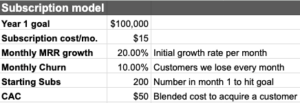A secret weapon of just about every startup I’ve been a part of in any capacity has been the use of a forward looking growth model. A strong growth model helps you clearly see what your growth goals are, and will enable you to make great decisions around growing your startup, including what you’ll need for a marketing budget, how headcount costs impact your bottom line, what your estimated revenue and burn will be each month, and much more.
It’ll also help you zoom into a monthly view that’ll help you see exactly how many sales you’ll need to make to hit your model – this will aid your customer acquisition model and give you a significant head start in terms of thinking through how you’ll grow the business.
In addition, for startups looking to raise capital, the growth model is one of the first things investors will ask for.
Step 1: Download the Growth Model Excel Sheet
Click here to download the excel sheet.
Step 2: Watch the overview of a growth model (Video)
Step 3: Watch building your growth model (video)
Step 4: Watch how to build a growth dashboard (video)
For those of you that prefer written content, here is the essentials of what I cover in the videos above:
Components of a growth model
There are a few components that make up a solid growth model. These will be used regardless of business model (i.e. transactional, subscription, marketplace, etc.).
Key inputs
The first component of a great growth model are key inputs. These include:
- Cost per unit – how much you are selling your product or service for
- Number of units sold within a period of time (i.e. month)
- Monthly growth rate – the goal growth rate on a month to month basis
For subscriptions, it’s also:
- Number of total active subscribers that you have (paying)
- Churn per unit of time
These are the main inputs that you will use as you build out and maintain your growth model. You may have other inputs you’d like to use as well, and I’d urge you to customize the model to fit the needs of your business. Just as no two businesses are alike, no two models are the same. For example, a subscription business who charges $20 per month per subscriber may also want to build in something like total users into their model as a way to track a leading indicator each month (as revenue is always a lagging indicator).
Growth rate
Tracking your growth rate and projecting this in your growth model will help you measure your month over month growth. Sometimes referred to as M/M or MoM growth, your growth rate will help you determine:
- How much revenue to expect over time
- How much budget you’ll need to hit your targets within a month
- How you’ll actually approach customer acquisition
While it’s all a best guess at the start, you generally will want to start with a round number like 10% or 20% and adjust every month until finding a baseline that you are comfortable with. If you are fundraising, most investors want to see a 10-20% monthly growth rate at a minimum. As you approach Series A and beyond, even stronger growth is likely needed to raise significant capital.
Also, please note that some business models are chunkier in general – enterprise SaaS may see more inconsistent growth, and consumer focused startups may see significant seasonality with their model. So adjust as you need to as you go.
Example data models
Below are a couple of example models that we’ll use for illustration purposes.
Transactional model example
Here is an example transactional model set of inputs:

And here is an example 12 month growth model based on these inputs:

Notice that our new sales grows each month tied to our 15 % month over month growth rate input that we created in the model.
Subscription model example
Here is an example subscription model set of inputs:


And here is an example 12 month growth model based on these inputs:


Notice that our number of new subscribers is rising, and that our churn % is pulling from the number of active subscribers from the prior month and using that number in the current month’s projection for total active subscribers.
Side by side comparison of two different churn scenarios
Now let’s look at two models side by side. The difference on a low cost subscription of 10% vs 20% churn is very material ($20k less revenue in year 1, $230k less in year 2) as seen in the charts below.
The 20% churn model is on top, the 10% churn model is below. Here’s a breakdown of the high level metrics with 10% vs 20% churn:



Notice that while keeping the marketing budget exactly the same, our Year 1 through Year 3 revenues are completely different. Churn has a huge impact on revenue!
As you find product/market fit, retention should get better. I prefer to model a higher early churn to be realistic with my models. For this model, I have a fixed growth rate. But the reality never matches that. Adjust your model as needed as you go along. And then recast your predicted future growth based on this data.
Marketing Budget & Scratch P&L
The last element I like to add to the growth model is what I call a “Scratch P&L.” This is not at all meant to replace working with your accountant to forecast and report on a real profit and loss statement, but this model below gives me a very rough sense of what my profit or loss will look like each month based on my model.
For this we’ll look at two new inputs:
- Marketing budget needed to hit the growth model goals based on your customer acquisition costs
- Headcount costs associated with the team salary and contractor payments, along with anything else you want to roll into the model, like office space rent.
Ideally you will look at your scratch P&L and compare that to your bank balance to make sure you have plenty of capital to keep your startup running.

When to update the model?
I generally update the metrics dashboard daily or weekly, and the forward looking model a couple times per month. What you likely will want to do is clone your forward looking model tab and call the clone “Metrics” and then use that for monthly lookback metric tracking for each of the metrics you’re using in the forward looking model.

Craig Zingerline is a 6 time founder who has helped dozens of companies scale their growth. Prior to Velocity Growth, Craig was the Chief Product Officer @ Sandboxx, Head of Growth at Upside Travel, CEO of Votion, Head of Growth at Red Tricycle, and VP at New Signature. In addition to in-house roles, Craig has advised and consulted with dozens of high growth startups (4 exits). He’s an award winning product strategist who has mentored hundreds of founders on growth, marketing, and product management.






